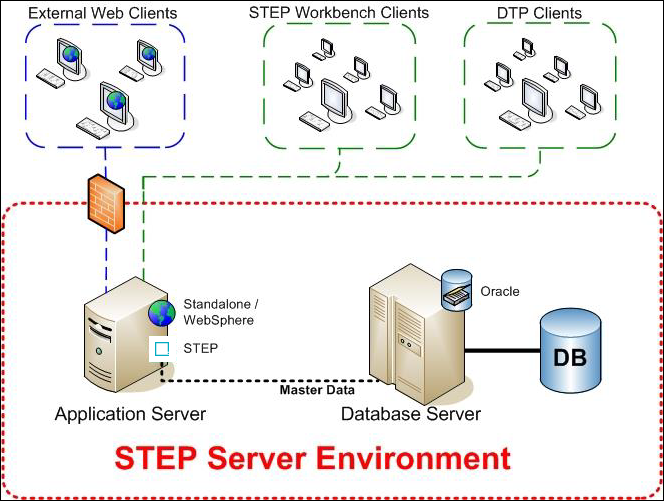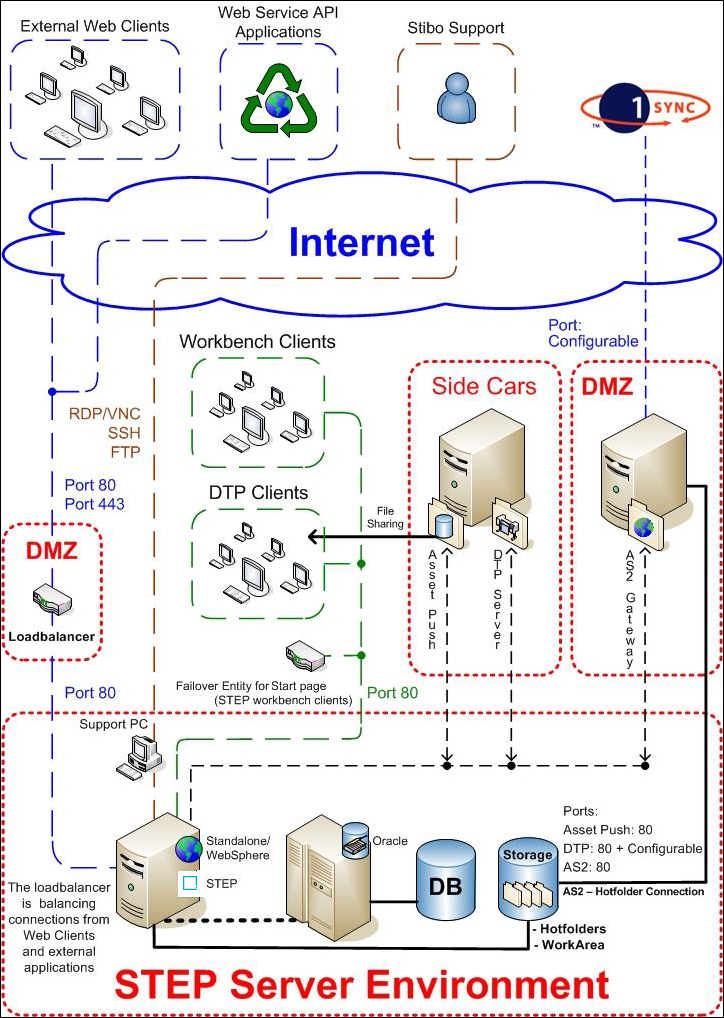This is one of the topics that describes the architecture of the STEP solution. The full list is defined in the STEP Architecture topic here.
STEP Architecture
This illustration shows a simple STEP system setup with one application server and one database server.

The Application Server is a physical server running either standalone (on Oracle Java) or a WebSphere Server. Within the application server, an instance of the STEP application is running, supporting three types of clients. The STEP Workflow component supporting business process management is part of the STEP application.
The Oracle Database Server provides the primary storage for all information to be stored persistently by the STEP system.
These types of clients are represented:
- STEP Workbench Client is a cross-platform, Java client providing the full set of functionality of the STEP application.
- External Web Client is an internet browser-based client providing functionalities used by users, suppliers, and vendors.
- Desktop Publishing (DTP) Client represents the InDesign application extended with a STEP DTP plug-in which allows the DTP application to communicate with STEP via a dedicated Web Service API.
Enterprise Architecture
The following comments apply to the illustration below which shows how the STEP system relates to its immediate surroundings.
- External applications communicate with the STEP system using the Web Service API or, as an alternative, the REST API. Additionally, other ways to integrate with the system are mentioned in the Integration topic (here).
- For simplicity, STEP is only represented as a single box. Refer to the STEP Architecture section above for more details.
- Sidecars denote a number of applications supporting the STEP Enterprise application functionality, such as:
- DTP server (either InDesign or QuarkXPress) provides operations such as proof views and PDF renderings of the DTP documents for users without DTP clients. It is possible to install multiple, physical DTP servers for load balancing and fail over.
- Asset Push Client listens for creation and updates of assets stored in STEP and automatically extracts a configurable version and subset of these assets to the file system. To allow DTP clients and servers faster access to images and further performance improvements, the output images can be synchronized to a file server near the DTP users if they are far away from the STEP system.
- AS2 gateway handles the AS2 communication with 1Sync. It can either be the OpenAS2 side car supplied by Stibo Systems or a customer-supplied (and perhaps pre-existing) AS2 gateway. The AS2 gateway should be placed in a separate DMZ for tighter control on the network traffic, so only incoming traffic from 1Sync is allowed on the configured port.
- DB represents the disks necessary for storing the data of the Oracle database being part of STEP.
- Failover Entity ensures that the Start page of the workbench does not become a single point of failure. The workbench application handles load balancing and failover directly and does not use this device once started, (refer to the Clustering topic here). The entity can either be a dedicated piece of hardware or a computer running an Apache web server with an appropriate proxy configuration.
- Loadbalancer provides an additional point of entry for external users (through the internet) accessing STEP. This point of entry is either a network box or a physical server capable of performing URL filtering together with session affinity, ensuring that the same session goes to the same server until the session times out. In effect, this box will perform load balancing and failover tasks for the STEP Web Client.
- For Stibo Systems Technical Support to be able to assist with troubleshooting problems, configure a remote connection from Stibo Systems to the customer hosting the system. This can be a Citrix-based connection or a direct VPN connection to a Support PC in the customer's network.
